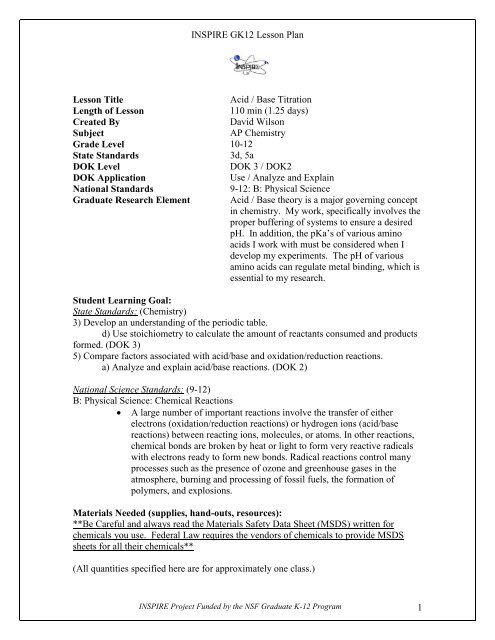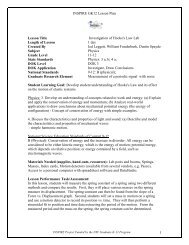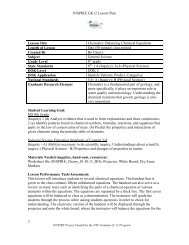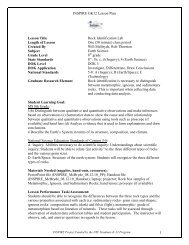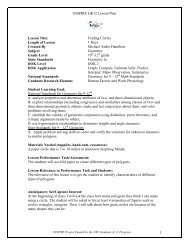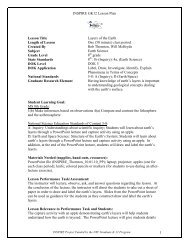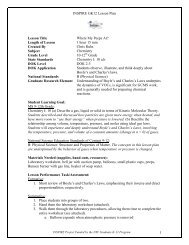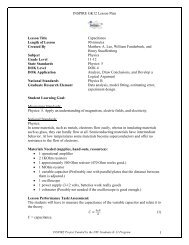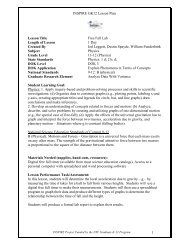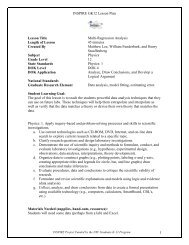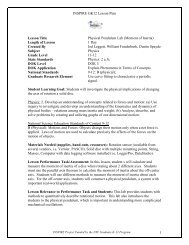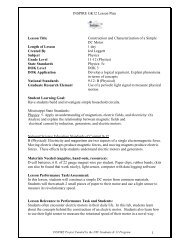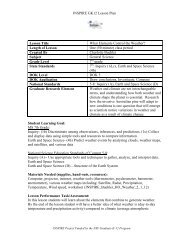Create successful ePaper yourself
Turn your PDF publications into a flip-book with our unique Google optimized e-Paper software.
INSPIRE GK12 Lesson Plan<br />
Lesson Title<br />
<strong>Acid</strong> / <strong>Base</strong> <strong>Titration</strong><br />
Length of Lesson<br />
110 min (1.25 days)<br />
Created By<br />
David Wilson<br />
Subject<br />
AP Chemistry<br />
Grade Level 10-12<br />
State Standards<br />
3d, 5a<br />
DOK Level<br />
DOK 3 / DOK2<br />
DOK Application<br />
Use / Analyze and Explain<br />
National Standards<br />
9-12: B: Physical Science<br />
Graduate Research Element <strong>Acid</strong> / <strong>Base</strong> theory is a major governing concept<br />
in chemistry. My work, specifically involves the<br />
proper buffering of systems to ensure a desired<br />
pH. In addition, the pKa’s of various amino<br />
acids I work with must be considered when I<br />
develop my experiments. The pH of various<br />
amino acids can regulate metal binding, which is<br />
essential to my research.<br />
Student Learning Goal:<br />
State Standards: (Chemistry)<br />
3) Develop an understanding of the periodic table.<br />
d) Use stoichiometry to calculate the amount of reactants consumed and products<br />
formed. (DOK 3)<br />
5) Compare factors associated with acid/base and oxidation/reduction reactions.<br />
a) Analyze and explain acid/base reactions. (DOK 2)<br />
National Science Standards: (9-12)<br />
B: Physical Science: Chemical Reactions<br />
A large number of important reactions involve the transfer of either<br />
electrons (oxidation/reduction reactions) or hydrogen ions (acid/base<br />
reactions) between reacting ions, molecules, or atoms. In other reactions,<br />
chemical bonds are broken by heat or light to form very reactive radicals<br />
with electrons ready to form new bonds. Radical reactions control many<br />
processes such as the presence of ozone and greenhouse gases in the<br />
atmosphere, burning and processing of fossil fuels, the formation of<br />
polymers, and explosions.<br />
Materials Needed (supplies, hand-outs, resources):<br />
**Be Careful and always read the Materials Safety Data Sheet (MSDS) written for<br />
chemicals you use. Federal Law requires the vendors of chemicals to provide MSDS<br />
sheets for all their chemicals**<br />
(All quantities specified here are for approximately one class.)<br />
INSPIRE Project Funded by the NSF Graduate K-12 Program 1
INSPIRE GK12 Lesson Plan<br />
1) Large bottle of vinegar (50 mL is necessary for each group for each trial.)<br />
2) 1.0 M NaOH solution (approximately 50 mL will be needed for each group for<br />
each trial.)<br />
3) 1 buret per group, attached to a ring stand with a buret clamp<br />
4) 1 250 mL beaker of Erlenmeyer flask per group (for the acid / base solution)<br />
5) 1 100 mL beaker per group (for the base to fill the buret)<br />
6) 1 funnel to fill the buret with base.<br />
7) 1 small dropper bottle of phenolphthalein<br />
Lesson Performance Task/Assessment:<br />
Students will<br />
Titrate an acid with a known concentration of base to calculate the concentration<br />
of the acid.<br />
Calculate the weight percent of acetic acid in vinegar<br />
Lesson Relevance to Performance Task and Students:<br />
This lab is an acid-base titration lab. In this lab students will collect the required skills<br />
and data to ultimately calculate the weight percent of acetic acid in vinegar.<br />
Anticipatory Set/Capture Interest:<br />
An introduction to the lab procedure with the required apparatus will serve as the<br />
anticipatory set.<br />
Guided Practice:<br />
I will instruct the students in how to perform the lab and what the endpoint will look like.<br />
Then they will perform the lab under my guidance.<br />
Independent Practice:<br />
The students will calculate the weight percent of vinegar on their own with only the<br />
information provided in the background.<br />
Remediation and/or Enrichment:<br />
Remediation: Individual IEP.<br />
Enrichment: Students will repeat their experiment twice more (three times total) and<br />
average their results to determine the standard deviation of their values and the percent<br />
error given the true weight percent value.<br />
Check(s) for Understanding:<br />
The students weight percent values will serve as a check for their understanding.<br />
INSPIRE Project Funded by the NSF Graduate K-12 Program 2
INSPIRE GK12 Lesson Plan<br />
Closure:<br />
I will ask the students to identify other acidic foods, and ask them to identify some<br />
unifying characteristics (i.e. sour taste, etc.)<br />
Possible Alternate Subject Integrations:<br />
Biology. <strong>Acid</strong>-<strong>Base</strong> chemistry is very important in biological systems.<br />
Teacher Notes:<br />
Reference: CHE-106 Lab Manual used at The University of Southern Mississippi;<br />
Woodruff, Frank and Howell, J. Emory. Chemical Principles in the Laboratory. The<br />
University of Southern Mississippi. 2000. {This particular lab was copyrighted in 1975.}<br />
**An Advanced Study Assignment is attached.**<br />
The lab is relatively easy to perform. Be sure all the glassware is cleaned. A basic lab<br />
procedure is listed below. Please see the lab manual for a more detailed background.<br />
Procedure:<br />
1) After cleaning the buret well, fill it with 1.0 M NaOH carefully. Make sure the<br />
buret stopcock is not dripping. In order to remove the air bubble from the buret<br />
tip, you must open the stopcock fully and allow some of the NaOH to run into a<br />
beaker. This should dislodge the bubble. You may need to refill the buret. Make<br />
a note of the measured location of the meniscus.<br />
2) Aliquot 50 mL of vinegar (from the store) into a 250 mL beaker or Erlenmeyer<br />
flask.<br />
3) Add three drops of phenolphthalein.<br />
4) Titrate the vinegar with the NaOH solution to the phenolphthalein endpoint. This<br />
should be a very pale pink endpoint.<br />
5) Note quantity of NaOH necessary to perform the titration.<br />
6) Calculate the number of moles of acetic acid in the vinegar. Then, convert that<br />
number to the number of grams of acetic acid in vinegar.<br />
7) Calculate the weight percent of acetic acid in vinegar.<br />
Calculations:<br />
Symbols: Molarity of acid = M A , Molarity of <strong>Base</strong> = M B , Volume = V<br />
Molarity of the Acetic <strong>Acid</strong> in Vinegar<br />
INSPIRE Project Funded by the NSF Graduate K-12 Program 3
INSPIRE GK12 Lesson Plan<br />
M A<br />
V A<br />
M B<br />
V B<br />
<br />
M A<br />
M B V B<br />
V A<br />
Moles of the Acetic <strong>Acid</strong><br />
<br />
moles A<br />
M A<br />
V A<br />
Grams of Acetic <strong>Acid</strong><br />
<br />
grams Acetic<strong>Acid</strong><br />
moles Acetic<strong>Acid</strong><br />
(MolarMass) Acetic<strong>Acid</strong><br />
Weight % Acetic <strong>Acid</strong> in Vinegar<br />
<br />
weight% grams Acetic<strong>Acid</strong><br />
grams vinegar<br />
(100)<br />
<br />
INSPIRE Project Funded by the NSF Graduate K-12 Program 4


